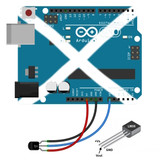Soldering Tutorial
If you want to make anything that involves an Arduino or raspberry pi that is a bit more involved than a flashing LED or media centre, the odds are that you are going to have to solder something to a circuit board.
Don’t worry – it’s much simpler than it looks and Proto-PIC have some fantastic soldering kits to get you started!
Soldering is a key skill to master if you want to work with electronics. It’s a tricky business too: if you want to attach metal wiring or components to a PCB (printed circuit board) a little finesse with a soldering iron goes a long way.
Basic Kit you will need

Clockwise from top left:
1. Solder Wire
A 60% tin, 40% lead wire (commonly called a 60/40) is probably the easiest solder wire to work with and is easy and inexpensive
2. Solder Iron and Stand
A pencil-style 25W will see you right. Don’t skimp on the wattage – longer heating times with cooler irons damage the integrity of your solder joint.
3. Sponge
Most stands should come with a sponge and a place to store it. A 100% cellulose sponge is the most effective. Before you start soldering, make sure that your sponge is dampened with water and wet to the touch.
4. Diagonal Cutters
A small pair of diagonal wire cutters will allow you to trim the excess from your newly soldered joints.
Getting started - Prepare your iron and PCB

Once you’ve turned on your iron and heated it to the correct temperature – 370 degrees centigrade should be about right for 60/40 wire – you need to clean the iron and ‘tin the tip’.
Wipe the tip of the iron on the damp sponge to prevent any oxidation and then immediately touch a small amount of solder wire to the tip of the iron and wipe it away on the sponge.
Never use anything abrasive to clean the tip, sandpaper or files will damage it.

Solder Iron A is an example of a dirty tip.
If you’re having trouble tinning, you can repair an oxidised tip by treating it with tip-tinning paste.
Solder Iron B is what you should be seeing – a thin, shiny layer on the tip of the iron.

To prepare the PCB, make sure that the contacts are free from dirt / fingerprints and oxidation by applying solder flux.
Putting your board in a vice or helping hands unit is a very useful way to steady it and leave your hands free to hold the solder and iron steadily– it’s really important that the parts being joined do not move as the solder cools, as you may end up with a faulty ‘cold joint.

If you are bonding wires to the PCB, strip away about 8mm of the plastic insulation to reveal the conductor. In the case of “Stranded” wires, twisting the conductors together will allow them to go through the PCB easier.
Since you will mostly be working “upside down” there is a tendency for any components or wires your are soldering to want to drop back out the hole you have put them in. Adding a slight bend to the legs or to the wire once you have them through the hole will prevent this. Alternatively you could hold the parts in place with some tap
Heat the wire or component leg at the point at which you wish to create a joint with the iron. Once the metal is heating, touch the tip of the solder wire between the iron and the wire / component so that it melts and flows into the hole and on your wire, joining them together.
Once enough solder has coated the join (it should only take a few seconds), carefully remove the iron and allow the solder to cool.

Once your joint has dried, clip the excess wire / component with the diagonal clippers as close as you can to the board.
A well-bonded joint will look like a smooth, shiny and slightly rounded and when done correctly should make you feel slightly superior to your colleagues
Take care not to breathe in the fumes while soldering - They are not pleasant! Only solder in a well ventilated area or preferably use a fume extractor
Common Issues

Common Issues (Clockwise from top left)
1. Overheated joint
This blackened mess was caused by the solder not flowing well, which usually happens because of a dirty or under-heated iron. You can fix the problem by cleaning gently with a toothbrush and rubbing alcohol and starting again.
2. Cold Joint
Cold joints are caused by not allowing the solder to melt completely. They make a circuit unreliable and prone to cracks.
You can recognise a cold joint by its rough / lumpy surface and can fix one by simply reheating the joint with your iron, being careful to remove any excess solder by drawing it off with the iron’s tip.
3. Disturbed joint
Disturbed joints look very similar to cold joints – crystalline and rough. However, such joints are caused by movement during the solder’s solidifying process. You can simply reheat the area and repair the damage but be sure to keep your tools as still as possible.
Recent Posts
-
What is Ohm's Law?
Are you curious about how electricity works? Let me introduce you to a very important concept i …9th Mar 2023 -
How do I control a central heating system using an Arduino
To control a heating system using an Arduino, you will need to write a sketch (program) that impleme …7th Feb 2023 -
The Versatility of Slotted Aluminium Extrusions: From Robotics to Camper Van Renovations
In today's ever-evolving world, the need for versatile and adaptable building materials is greater t …25th Jan 2023




